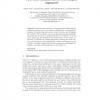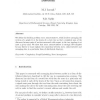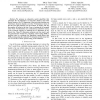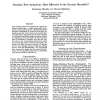510 search results - page 7 / 102 » Complexity measures and decision tree complexity: a survey |
ILP
2004
Springer
14 years 1 months ago
2004
Springer
Random forest induction is a bagging method that randomly samples the feature set at each node in a decision tree. In propositional learning, the method has been shown to work well...
DAM
2002
13 years 8 months ago
2002
We define the decision problem data arrangement, which involves arranging the vertices of a graph G at the leaves of a d-ary tree so that a weighted sum of the distances between p...
ISCIS
2009
Springer
14 years 1 months ago
2009
Springer
—We propose an exhaustive search algorithm that calculates the VC-dimension of univariate decision trees with binary features. The VC-dimension of the univariate decision tree wi...
KDD
1995
ACM
13 years 12 months ago
1995
ACM
Mostexisting decision tree systemsuse a greedyapproachto inducetrees -- locally optimalsplits are inducedat every node of the tree. Althoughthe greedy approachis suboptimal,it is ...
COCO
1995
Springer
13 years 12 months ago
1995
Springer
For the worst-case complexity measure, if P = NP, then P = OptP, i.e., all NP optimization problems are polynomial-time solvable. On the other hand, it is not clear whether a simi...




